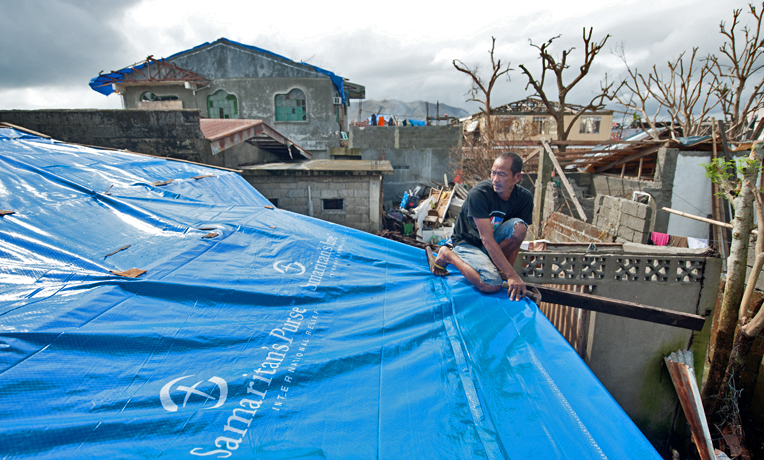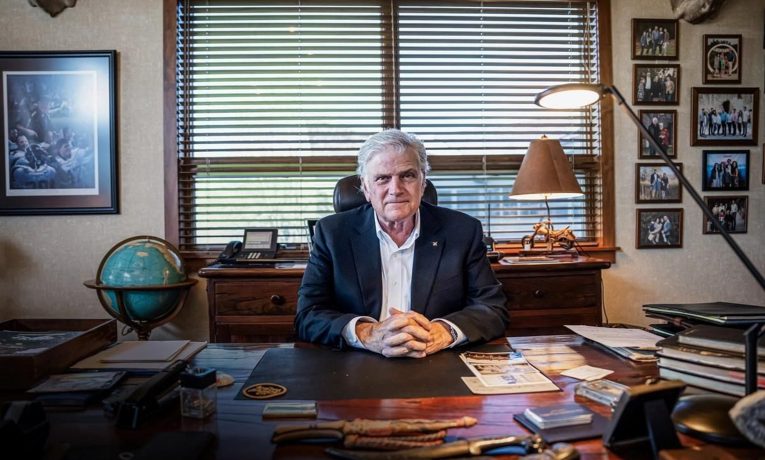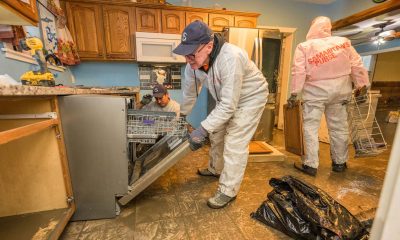The force behind Samaritan’s Purse’s growth into a billion-dollar nonprofit that brings comfort to a hurting world says "it’s all because of God."
By Beth Brelje | Originally Published in The Epoch Times May 02, 2024. Updated: May 06, 2024. Used with permission.
BOONE, N.C.—A bird is thumping into the window of Rev. Franklin Graham’s office at Samaritan’s Purse international headquarters in Boone, North Carolina.
He says it happens every spring, and he doesn’t know why, but this bird flies into the window, falls, and then tries again. Mr. Graham has gone outside to shoo it away—it doesn’t seem hurt—but it persistently bonks the window, sometimes in the middle of weighty, life-altering conversations.
It’s not the first time the views inside his windows have been breached.
Busloads of people used to stop in front of his boyhood home and sometimes they got off the bus, crept through the yard, and peered into the windows, hoping to get a glimpse of his world-famous father, the Rev. Billy Graham.
Seeking privacy, the family moved near his grandparents to a home on a wooded mountain acreage in Montreat, North Carolina. Mr. Franklin Graham and his four siblings attended a rural public school.
It dawned on the young Graham that his father was different from other dads when a family friend landed his helicopter in their yard and took Mr. Billy Graham to preach somewhere. It only happened a few times, but it left an impression.
His parents took him to church. His grandparents had been missionaries in China. Many of their friends were retired missionaries, so the Graham home was often filled with people of faith.
But young Franklin Graham rebelled against it.
“As I got into my teenage years, it wasn’t that I did not believe in God. I just didn’t want God running my life,” Mr. Graham told The Epoch Times. “I wanted to have fun. I wanted to do those things that pleased me and satisfied myself. I was probably very self-centered.”
He picked up bad habits, like smoking cigarettes, as he traveled the world.
One night, at age 22, and alone in a Jerusalem hotel room, everything changed.
“I found myself at a point in life where I was just miserable. And I got on my knees one night and I said, ‘God I believe you’re real, and I believe your son Jesus Christ took my sins to the cross and died for me. I’ve sinned against you. I’m sorry. If you can take the pieces of my life and put them together, you can have it,’” Mr. Graham recounted.
“That night, when I prayed that prayer, I meant it. I didn’t know everything all that entailed, but I knew I surrendered that night.”
The next morning, he woke up and decided he would be a better witness for God if he didn’t smoke. But a few days later on an airplane, a flight attendant was selling cigarettes. He bought a pack.
“I lit one up and for the first time, it didn’t taste good. I put it down and never touched one since. So, I gave my life to Christ and decided to quit smoking for Him, then He took away the desire, and the taste. I mean, I loved cigarettes…. nicotine is a real addiction, and God delivered me from it.”
Soon, he married his wife, Jane Austin. Today, they have four married children—Will, Roy, Edward and Cissie—and 13 grandchildren.
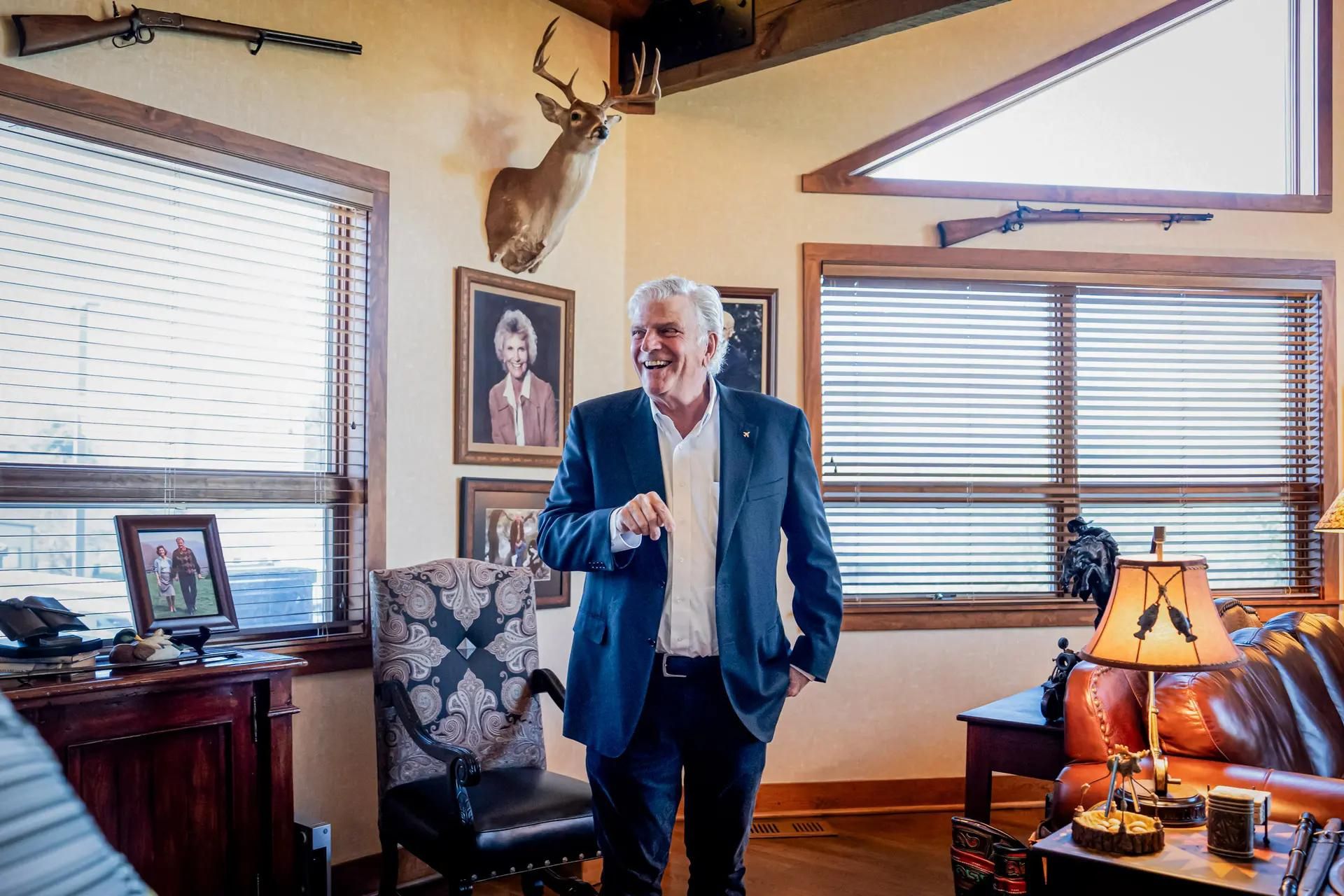
Franklin Graham, president and CEO of Samaritan’s Purse and the Billy Graham Evangelistic Association, laughs as he shares the stories of some of the items in his rustic office in Boone, N.C., during an interview with The Epoch Times on April 18, 2024. (Madalina Vasiliu/The Epoch Times)
Finding a Mission
While Mr. Graham was in college, Bob Pierce, founder of Samaritan’s Purse, invited him on a mission trip. It sparked a passion for serving people.
Samaritan’s Purse was a small nonprofit that helped missionaries. After Mr. Pierce received a terminal prognosis for his leukemia, he asked Mr. Billy Graham if his son Franklin, who was still in college, would take it over.
“My father said, ‘If you want Franklin, you have to talk to him,’” Mr. Graham said.
“He died, but never talked to the board of directors about it. So, I go to his funeral and the board is looking at me like ‘what are you doing here?’”
A year later, the board offered him the job.
In 1979, at 26 years old, Mr. Graham was elected president of Samaritan’s Purse.
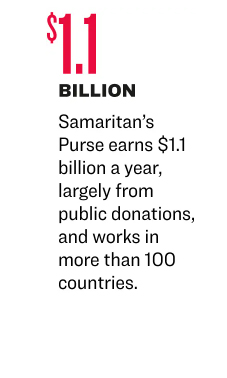
Today Samaritan’s Purse earns $1.1 billion a year, largely from public donations; employs 4,464 people, and works in more than 100 countries, providing aid to victims of war, disease, disaster, poverty, and famine.
Everything Samaritan’s Purse does is connected to evangelism.
Tens of thousands of churches in the United States and 100 other countries participate in Samaritan’s Purse’s Operation Christmas Child, in which churchgoers pack a shoebox with gifts. Boxes are distributed to needy children around the world, and they are invited to join a faith-based program called The Greatest Journey. More than 11.3 million boxes were collected globally in 2023.
“It’s all because of God. It started off with me at the beginning, not knowing what in the world I got myself into. And it goes back before that, to when I gave my life to Christ,” Mr. Graham said. “When we pray those prayers and we mean it, God will take our life and use us in a way that we never dreamed possible.”
At 71, Mr. Graham is neither retired nor spends all his days behind a desk. His sleeves are rolled up; he still travels to inhospitable places where people are hurting; and he has a lot to say about the condition of the world today, that has created so much need.
Samaritan’s Purse has large, long-term responses in Ukraine and now Israel.
In Ukrainian cities where homes are heated by centralized steam heat plants, underground piping for heat and water has been demolished. People are living in their basements. Samaritan’s Purse has been providing heat and water by giving people wood burning stoves and drilling wells.
Samaritan’s Purse replaced 14 destroyed ambulances in Israel and will provide eight additional armored ambulances.
“Hamas targeted ambulances because they wanted to kill the drivers and the people in the ambulances so it would discourage other ambulances from coming,” Mr. Graham said.
Samaritan’s Purse has offered to set up a fully-equipped emergency field hospital inside Gaza and it has purchased 3,000 family-size tents for displaced Gaza civilians. These are being transported in more than two dozen 40-foot containers that are expected to begin arriving in the first half of May.
Mr. Graham said the organization only goes where it’s welcome by the government.


(Top) The Samaritan’s Purse warehouse in North Wilkesboro, N.C., on April 18, 2024. (Bottom) Franklin Graham and Samaritan’s Purse dedicate 14 ambulances to fallen medics in Israel on Jan. 23, 2024. (Madalina Vasiliu/The Epoch Times, Courtesy of Samaritan’s Purse)
The Tumultuous World
While recently in Poland, Mr. Graham visited Auschwitz, where 1.1 million Jewish people were murdered by the Nazis.
“We come today, 80 years down the road, and we see the rise of anti-Semitism again … Iran has declared they’re going to wipe Israel off the map,” Mr. Graham said.
“Iran doesn’t care about the Palestinians. They’re just using the Palestinians to accomplish their goal. The Palestinians suffer; Hamas doesn’t care. They are there to be able to destroy Israel and … the more Palestinian suffering, the more world attention will be against Israel. We’re seeing this happening right now.”
The Arabs claim to have compassion for the Palestinians, he said, but Egypt, Jordan, Saudi Arabia, and Libya haven’t taken in fleeing Palestinians.
Palestinians are suffering, he said. The border was closed; they cannot leave. They don’t have jobs or income anymore, and they have no effective government to help them.
Samaritan’s Purse has helped displaced Jewish people, first with food boxes, then gift cards to buy what they need, like diapers and infant formula. Some 500,000 Jewish people have been displaced.
Samaritan’s Purse has a mobile hospital ready for the region and is working with Israel to find the safest time to set up.
Mr. Graham looks to the Bible to make sense of the world, and he sees parallels in scripture and current events. The Bible speaks of a one world government.

“The globalists want a one world economy. They want a one world government system, and that’s being talked about. Is it being talked about in the media? No. But that’s the agenda, and the Bible predicts that, so it’s all part of God’s plan,” Mr. Graham said.
Other signs are electronic currencies. Mr. Graham believes eventually the world will agree to one electronic currency, ending cash.
“The Bible talks about a mark on the forehead or on the right hand. I believe it’s a computer chip, so you don’t have to carry money… That technology is here today.”

(Left) A poster listing Samaritan’s Purse emergency field hospital deployments hangs at its warehouse in North Wilkesboro, N.C., on April 18, 2024. (Right) Bibles sit on a work table alongside safety equipment and orange volunteer t-shirts. (Madalina Vasiliu/The Epoch Times)
The Bible predicts these things will usher in a time of turmoil before the return of Jesus Christ.
“I’m not afraid, but I’m not unaware of where the world is heading.”
“Until that happens, there will be a lot of hurting people in this world and I’m going to do all I can to try to help as many as I can, and do it in Jesus’ name,” Mr. Graham said.
“I want the world to know that God loves them. I’m going to take as many days as I have left, to try to tell as many people as I can.”
Battling Storms
After a 2023 tornado ripped up hundreds of Indiana homes, Jason Kimak, Samaritan’s Purse senior director of North American Ministries, was sent to a man’s home.
“I drove up and the home was really messed up. I mean it was crumbled. I get out of my car…and the first thing he says to me is, ‘For years, I’ve packed shoe boxes with Samaritan’s Purse Operation Christmas Child. I never thought in a million years that you would be coming to help me with my home.’
“He started sobbing. It was emotional. His home was mostly destroyed.” Mr. Kimak told The Epoch Times.
They walked around the wrecked home. The man showed how he scrambled into his basement to survive the tornado. Samaritan’s Purse volunteers helped sort through the rubble, recover a few things, and put them in a container until he had a new place.
Mr. Kimak spoke from inside a ready-to-deploy disaster relief unit staged in the Samaritan’s Purse warehouse in North Wilkesboro, and outfitted with a command center office, a communication hub where most surfaces are made of white board so disaster responders can scrawl notes on the walls. The trailer has a workbench to repair equipment, and cabinets filled with gear to respond to destroyed homes and unsettled lives. Near the work gloves and chainsaws is a cabinet filled with orange volunteer t-shirts and stacks of Bibles.
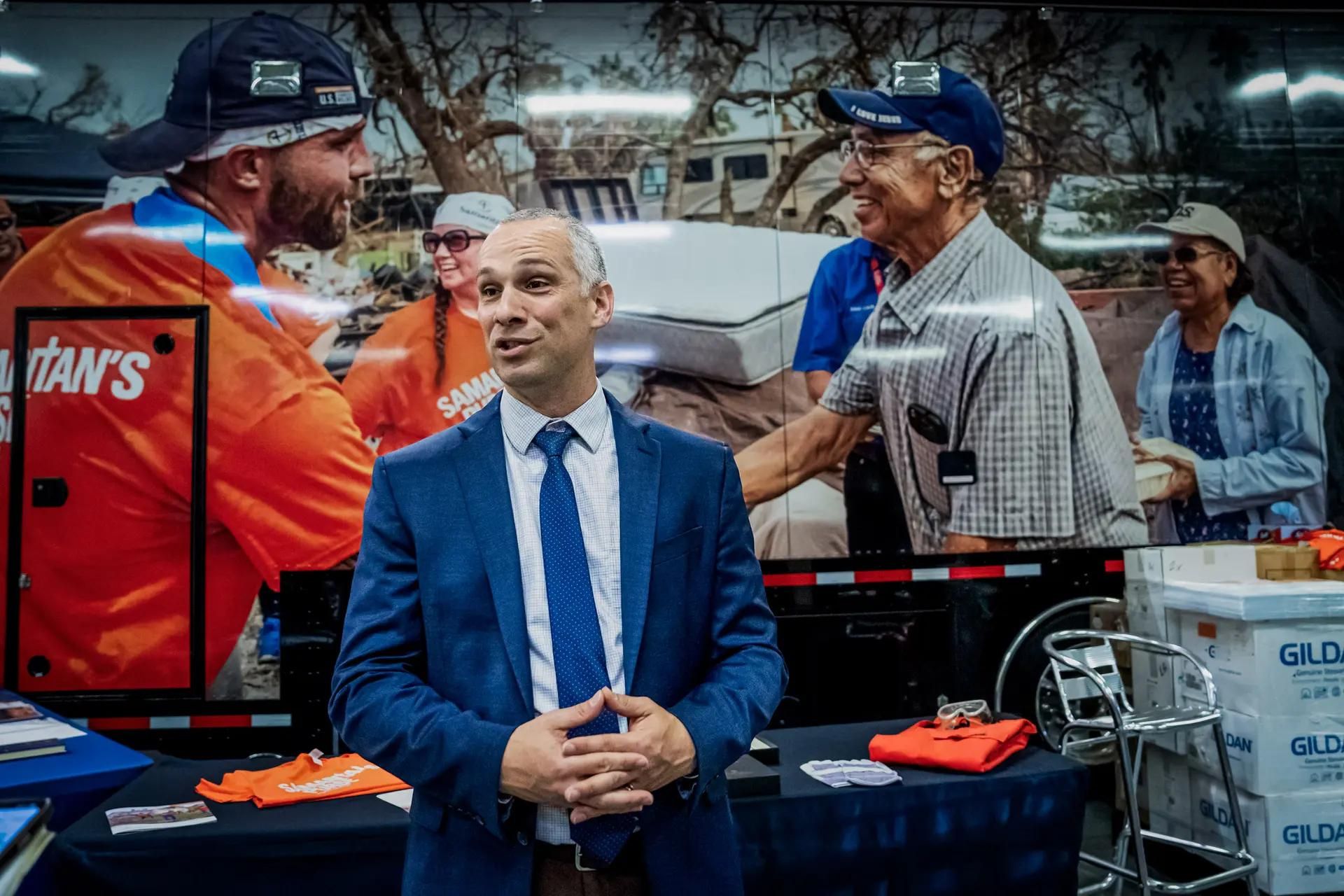
Jason Kimak, Samaritan’s Purse senior director of North American Ministries, at the Samaritan’s Purse warehouse in North Wilkesboro, N.C., on April 18, 2024. (Madalina Vasiliu/The Epoch Times)
Churches that provide or receive shoeboxes are willing to partner with Samaritan’s Purse in disaster situations, making for quick local connections, domestically and internationally.
Since 1998, Samaritan’s Purse has responded to 342 domestic disasters in 39 states, bringing aid to some 74,000 families.
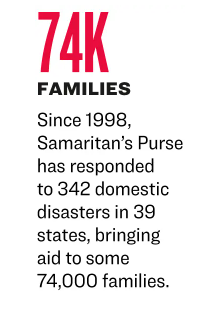
During the Fort Myers, Florida, hurricane response, Mr. Kimak saw a man looking at his damaged garage, where filthy, five-foot deep flood water soaked the walls and contents of homes. He didn’t know where to start. Mr. Kimak offered to put in a work order.
“He said, ‘How much is that going to cost?’ I said, ‘There is no cost. See all these people in the orange t-shirts? They come from around the country to serve and help you.’
“He just was blown away.”
Samaritan’s Purse salvaged belongings, moved furniture outside to dry in the sun, removed flooring, wet drywall and insulation, and applied a mold preventative. They did the same next door at the man’s mother’s house.
In a disaster, people are in shock. Chaplains from the Billy Graham Evangelistic Association listen to their stories, pray with them, and help them through the first steps of recovery.
“A lot of times, just because that storm came in physically, there may be other storms in their life they’ve been going through,” Mr. Kimak said. They are given a Bible and connected with a local church that will continue to work with them.
Samaritan’s Purse looks to offer lasting hope. After responding in 2021 to tornado destruction in Mayfield, Kentucky, Samaritan’s Purse purchased land and built 60 new houses to give to people. Each comes fully furnished and has a storm room able to withstand an EF-5 tornado.
Families receiving a home take a course facilitated by Mayfield churches for first-time homeowners to grow financial management skills.
Rapid Growth, Rapid Response
Samaritan’s Purse first deployed one of its emergency field hospitals in 2016 in the aftermath of a devastating earthquake in Ecuador. Operating rooms and emergency rooms were up and running less than 11 hours after the plane landed.
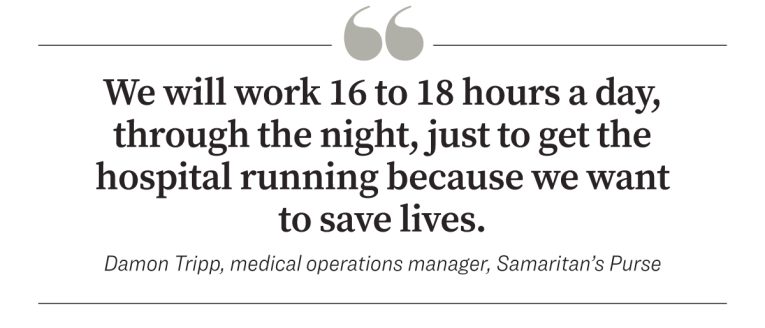
“Time matters. Whenever we hit the field, the faster we can get in there, the more lives we’ll save,” Damon Tripp, Samaritan’s Purse’s medical operations manager told The Epoch Times, while walking through the 164,000-square-foot North Wilkesboro warehouse built in 2017.
“We will work 16 to 18 hours a day, through the night, just to get the hospital running because we want to save lives, and it gives us the ability to let them know that God loves them.”
The goal is to be operating in less than 72 hours, Mr. Tripp said. “That is the golden window of opportunity to save the most lives and treat the most people.”
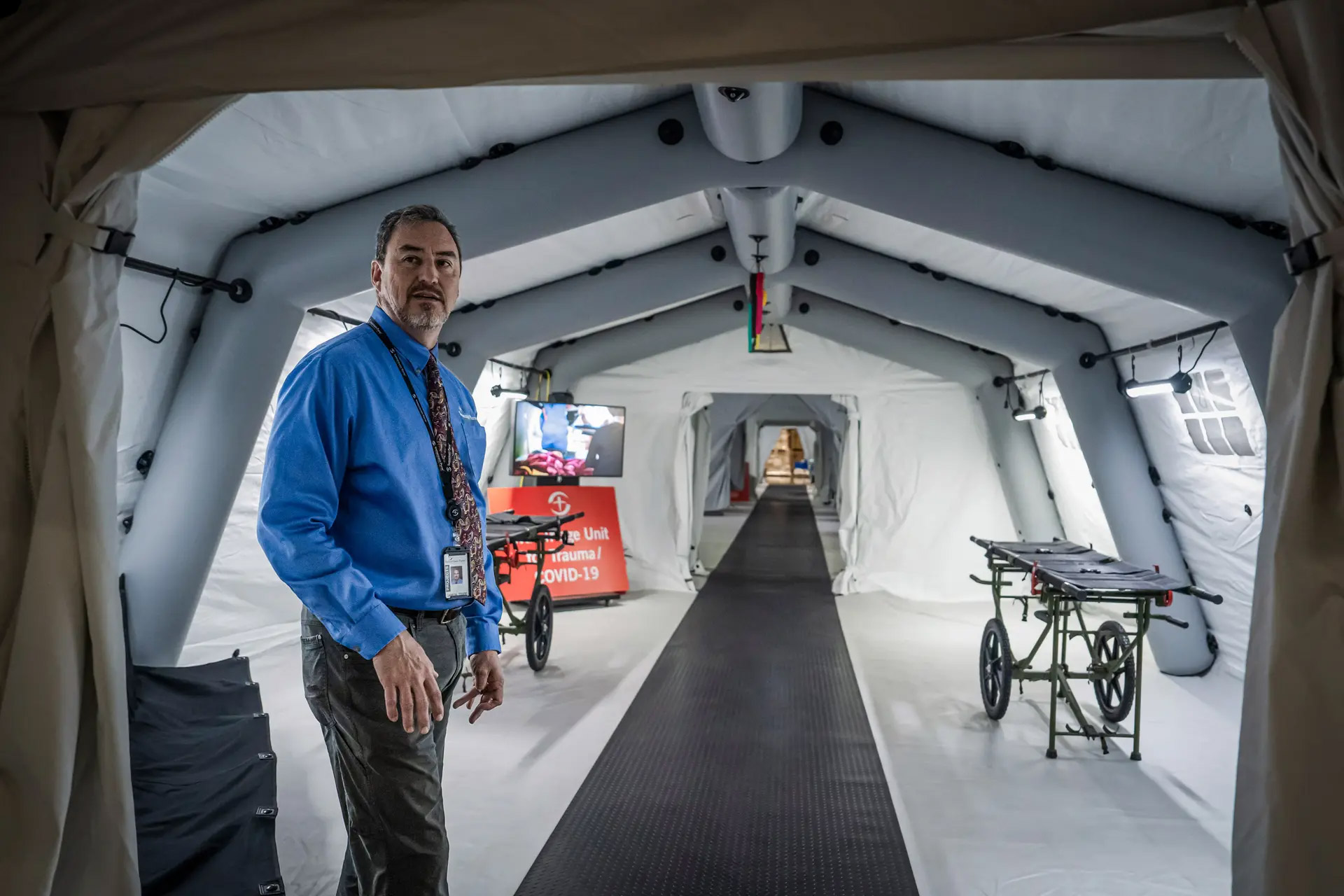

(Top) Damon Tripp, Samaritan’s Purse medical operations manager, at the Samaritan’s Purse warehouse in North Wilkesboro, N.C., on April 18, 2024. (Bottom) Samaritan’s Purse warehouse in North Wilkesboro, N.C., on April 18, 2024. (Madalina Vasiliu/The Epoch Times)
The emergency field hospital is inflatable. Rooms can be joined together. There is a waiting room with chairs, and four rolls of colored triage tape hang from the ceiling for workers to color-code patients by severity of injury. The next room has portable treatment beds with heart monitors. Another room is a surgical suite.
Specialty equipment is sent to disaster zones as needed.
“If we’re going to an earthquake and there are a lot of crush injuries, we have a ‘crush module’ we’ll send. If we have a malnutrition need, we have a module that just covers that area,” Mr. Damon said.
During the earthquake response in Turkey, they were amazed to see people pulled out of the rubble alive, 10 days later, Mr. Tripp said.
Samaritan’s Purse gains knowledge with each deployment. Dr. Kent Brantly, a Samaritan’s Purse doctor caring for patients in Liberia in 2014 contracted highly contagious Ebola while working to contain a deadly outbreak. He was flown to the United States for treatment in a medical evacuation plane equipped with a special containment unit.
After that, Samaritan’s Purse began annual training for infectious disease response.
“We used the skills that we acquired through Ebola to respond to COVID, which nobody knew anything about. So, we were one of the first to respond as an NGO to COVID,” Mr. Tripp said.
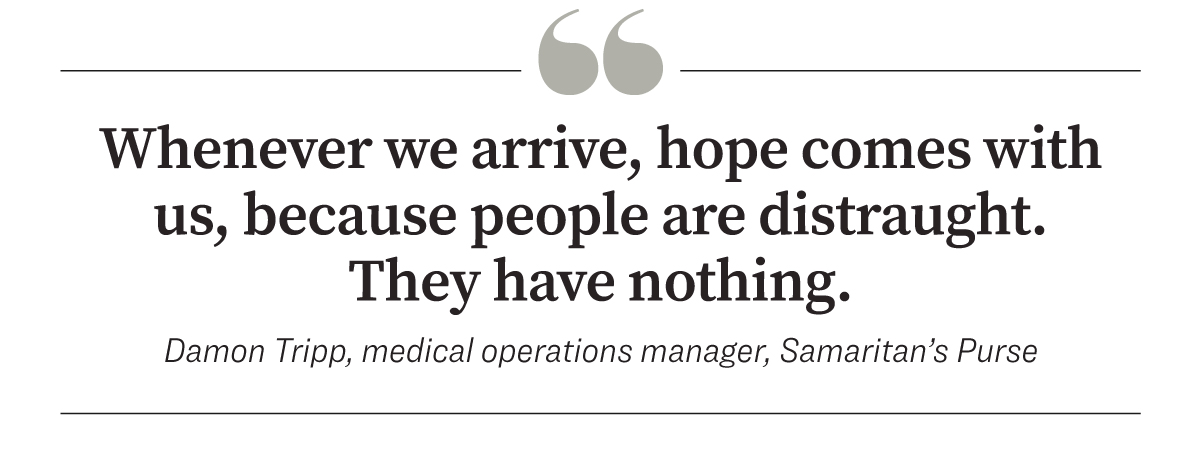
Early in the pandemic, Cremona Hospital in Italy’s Lombardy region, was overwhelmed. Doctors had to decide who to treat and who to let die.
Samaritan’s Purse set up a 68-bed mobile hospital equipped with specialized respiratory care in the parking lot. Later in 2020, Samaritan’s Purse set up COVID-19 response hospitals in New York City’s Central Park; Lenoir, North Carolina; Lancaster, California; and Jackson, Mississippi.
Samaritan’s Purse has 11 field hospitals including small outpatient hospitals and large in-patient hospitals. They have been deployed for cholera treatment in Haiti; war trauma in Mosul, Iraq; blast response in Beirut, Lebanon; hurricane response in the Bahamas; war trauma in multiple Ukraine locations; and earthquake response in Antakya, Turkey.
“Whenever we arrive, hope comes with us, because people are distraught. They have nothing. They’ve lost everything. In Turkey, at least 50 percent of the people lost a loved one in that earthquake,” Mr. Tripp said. “The hope that comes—and it’s not from us—the hope that we have in Jesus Christ is massive, and people see that.”
Samaritan’s Purse also offers children surgical cleft palate clinics; and has arranged for life-saving cardiac surgery for more than 1,500 children in more than a dozen countries.
Wings and Prayers
Samaritan’s Purse has 24 aircraft, including two helicopters and two cargo planes—a Douglas DC-8 and a 1985 Boeing 757 purchased in 2022. After extensive upgrades in avionics and communication systems, the Boeing’s first relief mission was delivering 24 tons of cargo to Maui, Hawaii, to help wildfire victims.
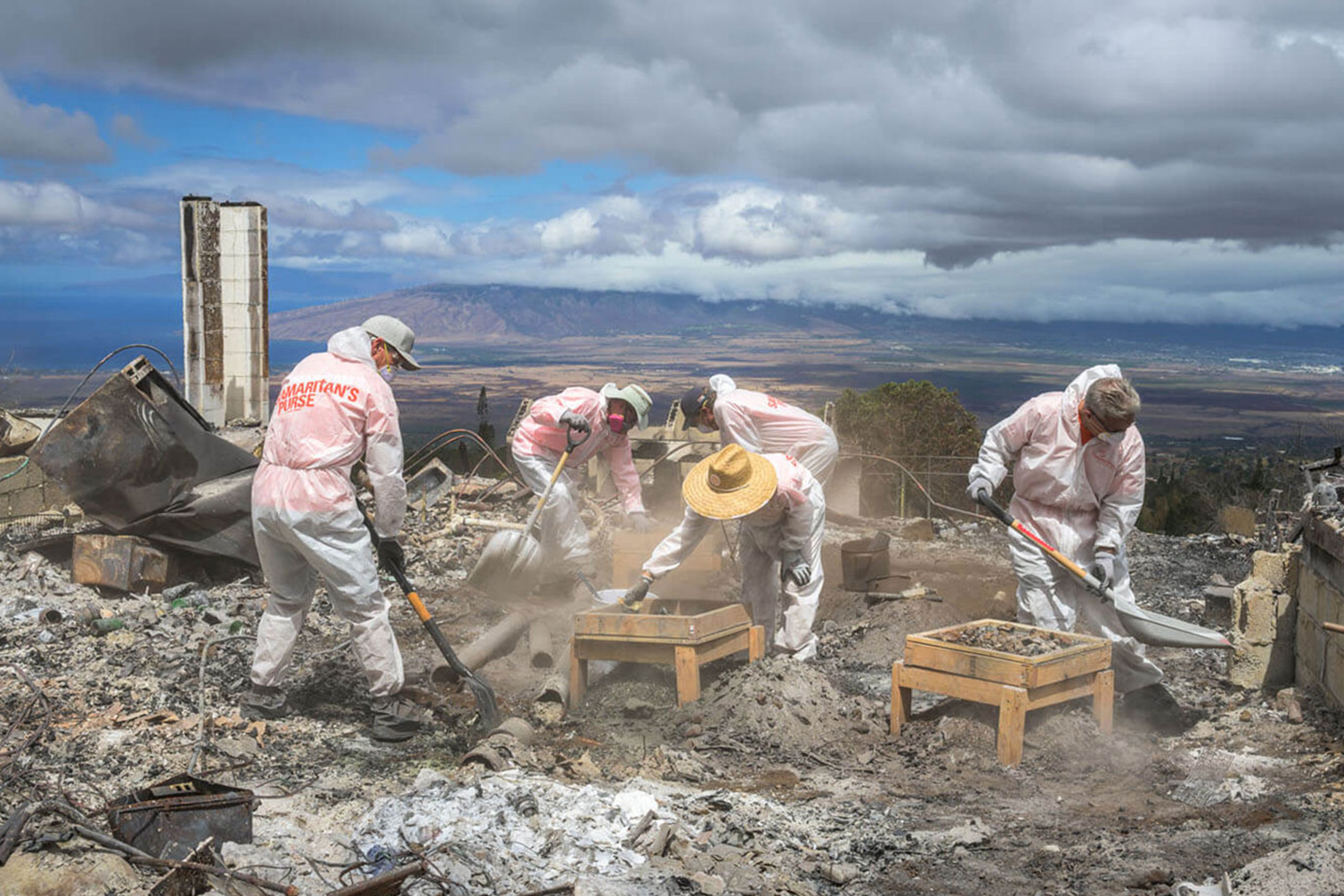
Volunteers from Samaritan’s Purse search for personal items in the rubble of a home in Lahaina, Hawaii in October 2023.
When Samaritan’s Purse is deployed, materials in the warehouse are loaded onto trucks, hauled to the airport, and loaded onto an airplane.
“We do mission work. We do it on a big scale. And we do it well,” Andrew Klischer, director of operations for Samaritan’s Purse, Mission Aviation Services told The Epoch Times as he walked on the pristine, white floor of the airplane hangar in Greensboro, North Carolina.
“When we deploy, there is a recipient on the other end that will receive what we’re bringing, and it will change their life. And that’s not glory to us. We offer people that are hurting or needy, immediate response, in Jesus’ name.”
Every person at Samaritan’s Purse gives credit to God.
Samaritan’s Purse arrives fully self-sufficient, bringing MREs (Meals Ready-to-Eat), generators, and a water filtration system developed by their own engineers. They bring everything needed for responders to bathe, sleep, and manage waste, so they are not taking resources from already depleted areas.

Andrew Klischer, director of operations at Mission Aviation Services, at the Samaritan’s Purse airport hanger in Greensboro, N.C., on April 18, 2024. (Madalina Vasiliu/The Epoch Times)
They also pack items to give away, including solar lanterns that can charge a phone when the power is out, and waterproof blue tarps that cover homes without roofs or form the foundation under field hospitals.
In the warehouse, large photographs, some covering entire walls, remind employees how their work is felt. Some photos are joyful, like the veteran rising from a freshwater baptism in Alaska, where Samaritan’s Purse hosts Operation Heal Our Patriots, a marriage program for couples to reconnect and adapt to life changes. Many from this program train as volunteers for future disaster response.
One photo shows a Samaritan’s Purse nurse in Iraq, tenderly holding a shirtless toddler with shrapnel wounds on the child’s back.
“It’s the best job I’ve ever had. It’s the best thing I’ve ever been a part of,” aviation mechanic Matt Youngs told The Epoch Times while getting lunch in the cafeteria.
Also in the cafeteria was Steve Nickel, vice president of Donor Ministries, who said the organization doesn’t do traditional fundraising. People see their work, and they give.
“We didn’t do this; God did this. We have one donor [God] if we do everything to please Him, we will have everything we need,” Mr. Nickel said of Samaritan’s Purse’s growth.
“We just want to show people what God is doing, and people do the rest. To ask people for money misses the point.”
He says people see their work, God works on their hearts, and they trust God to provide. “It’s very freeing.”
Back at Mr. Graham’s office, that little bird possibly noticed through the window, a flurry of phone calls and meetings as Samaritan’s Purse whirled into action again, responding to deadly tornadoes and storms in Nebraska, Iowa, and Oklahoma.
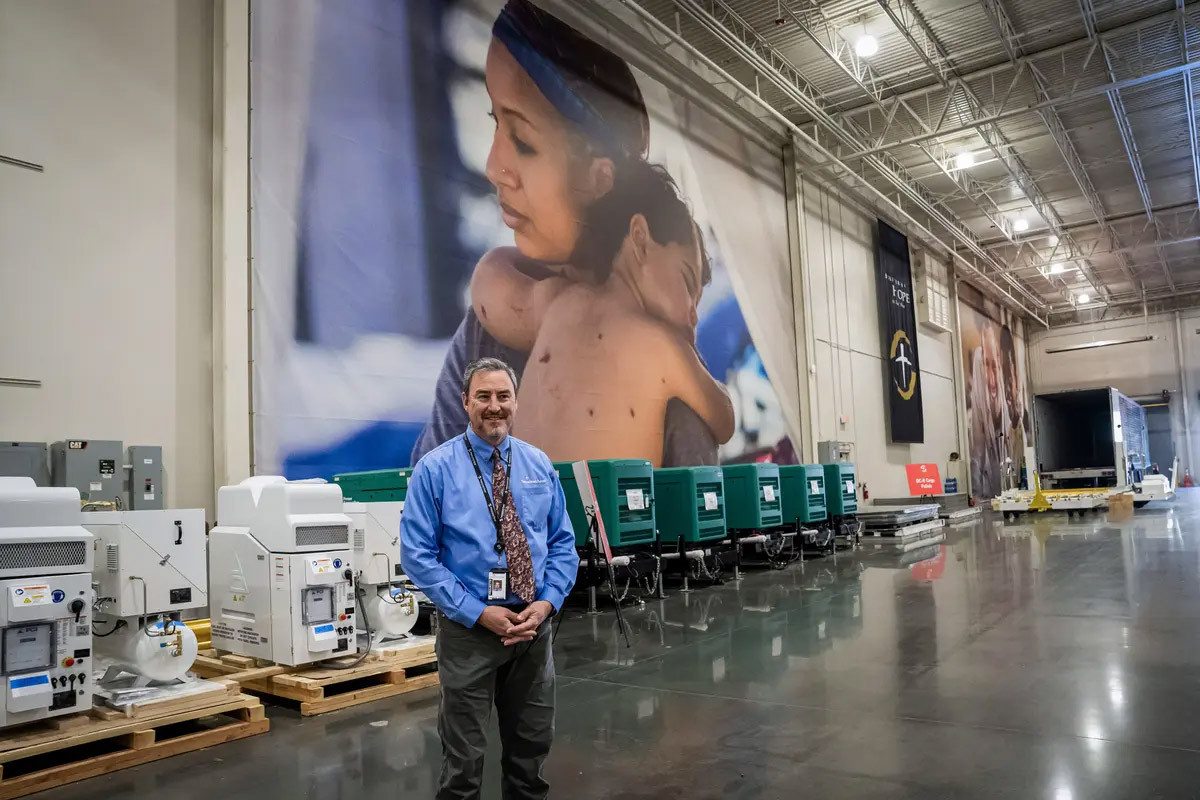
Damon Tripp stands in front a giant photo of a Samaritan’s Purse nurse holding a toddler in Iraq at the Samaritan’s Purse warehouse in North Wilkesboro, N.C., on April 18, 2024. (Madalina Vasiliu/The Epoch Times)
